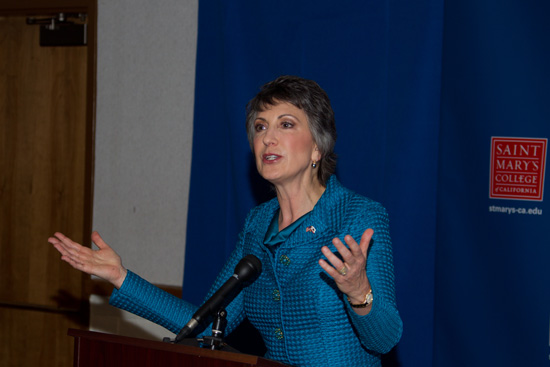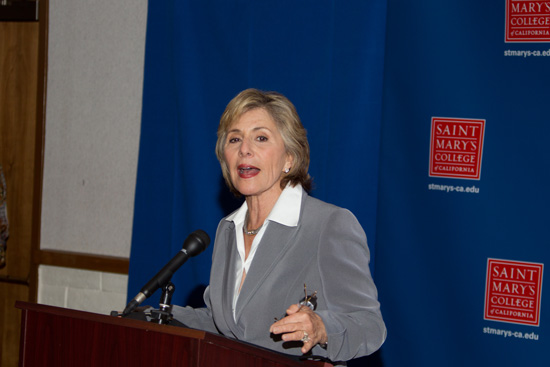 |
|
|
Cars line up at Saint Mary's check point Photo Doug Kohen
|
|
|
|
|
|
“It was a great day to be on campus; students were very enthused by the event and teachers teaching public affairs were ecstatic,” said Steve Woolpert, the Dean of Liberal Arts at St. Mary’s College.

 For a few hours on September 1st, SMC became the center of major media attention, during the first face-off in the California senatorial race between incumbent Barbara Boxer and challenger Carly Fiorina. No clear winner emerged from the debate. “They were both effective in addressing their own constituents and in trying to motivate undecided voters,” said Father Michael Russo, who teaches a course on Political Communication. For a few hours on September 1st, SMC became the center of major media attention, during the first face-off in the California senatorial race between incumbent Barbara Boxer and challenger Carly Fiorina. No clear winner emerged from the debate. “They were both effective in addressing their own constituents and in trying to motivate undecided voters,” said Father Michael Russo, who teaches a course on Political Communication.

 Fiorina started the debate with an attack on Boxer, saying that her 28-year track record was devastating for California. Boxer replied that her opponent received millions of dollars as chief executive at Hewlett Packard while laying off thousands of workers and sending manufacturing off-shore before she herself was let go for poor results. Fiorina started the debate with an attack on Boxer, saying that her 28-year track record was devastating for California. Boxer replied that her opponent received millions of dollars as chief executive at Hewlett Packard while laying off thousands of workers and sending manufacturing off-shore before she herself was let go for poor results.

 Both took the expected positions on the issues. Fiorina runs on creating jobs through deregulation, and taking back the government from Washington politicians; while Boxer runs on her results and emphasizes the social choices she represents. Fiorina listed strategies such as the creation of jobs zones, while Boxer talked about Proposition 23 (that would freeze the Global Warming Act of 2006 until the state unemployment rate drops), and a woman’s right to choose. Both took the expected positions on the issues. Fiorina runs on creating jobs through deregulation, and taking back the government from Washington politicians; while Boxer runs on her results and emphasizes the social choices she represents. Fiorina listed strategies such as the creation of jobs zones, while Boxer talked about Proposition 23 (that would freeze the Global Warming Act of 2006 until the state unemployment rate drops), and a woman’s right to choose.

 On job creation, “We will have to make tough choices, but we’ll create jobs through deregulation and tax cuts to the private sector,” Fiorina concluded. “The Small Business bill will create jobs and what we did avoided a 1929-type catastrophe,” stated Boxer. On job creation, “We will have to make tough choices, but we’ll create jobs through deregulation and tax cuts to the private sector,” Fiorina concluded. “The Small Business bill will create jobs and what we did avoided a 1929-type catastrophe,” stated Boxer.

 Russo, a Professor of Communication in SMC’s School of Liberal Arts, and Liberal Arts Dean Steve Woolpert commented on the debate. Russo, a Professor of Communication in SMC’s School of Liberal Arts, and Liberal Arts Dean Steve Woolpert commented on the debate.

 “Boxer presented herself as a long-seated senator who has delivered every day for Californians,” said Russo, “while Fiorina (offered) to bring a new vision and a new energy.” “Boxer presented herself as a long-seated senator who has delivered every day for Californians,” said Russo, “while Fiorina (offered) to bring a new vision and a new energy.”

 Woolpert agreed both candidates were effective, “What they did well was to speak to their core constituency on social issues, Boxer on environmental matters and women’s rights, and Fiorina on guns and immigration,” he said, “and on the economy, they had a similar strategy of attacking and neutralizing the other to attract the undecided and swing voters.” Woolpert agreed both candidates were effective, “What they did well was to speak to their core constituency on social issues, Boxer on environmental matters and women’s rights, and Fiorina on guns and immigration,” he said, “and on the economy, they had a similar strategy of attacking and neutralizing the other to attract the undecided and swing voters.”

 Woolpert expressed concern that this kind of negative strategy might lower social trust and democratic engagements. “When the electorate is frustrated and anxious, candidates tend to try to find someone to point the finger at rather than emphasizing their own proposals,” he added. Woolpert expressed concern that this kind of negative strategy might lower social trust and democratic engagements. “When the electorate is frustrated and anxious, candidates tend to try to find someone to point the finger at rather than emphasizing their own proposals,” he added.

 As for the outcome of the election, Woolpert believes that it will depend on the ability of each candidate to motivate people to actually vote. “There are more registered Democrats than Republicans in California, so if Democrats turn out Boxer will win,” he said, “however, at this time Democrats feel a bit down and Republicans are energized.” As for the outcome of the election, Woolpert believes that it will depend on the ability of each candidate to motivate people to actually vote. “There are more registered Democrats than Republicans in California, so if Democrats turn out Boxer will win,” he said, “however, at this time Democrats feel a bit down and Republicans are energized.”

|


